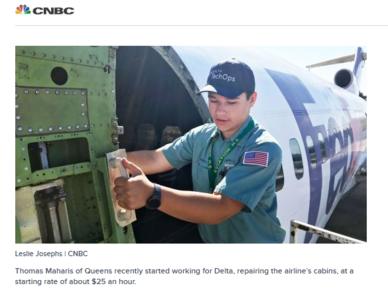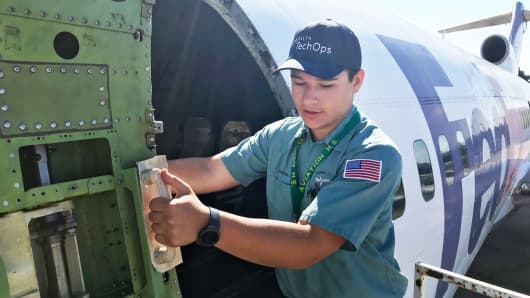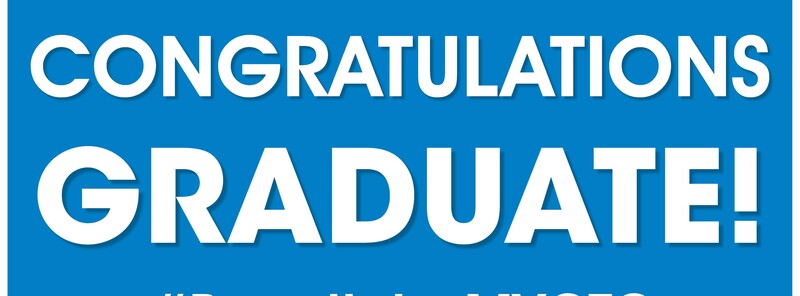- Boeing estimates the aviation industry will need 754,000 new aircraft technicians over the next 20 years.
- About 30 percent of the current ranks of aircraft mechanics are at or near retirement age and they're retiring faster than they're being replaced, the Aviation Technician Education Council said.
- Young mechanics can quickly earn $72,000 a year.
The aviation industry needs to hire thousands of more people like Thomas Maharis.
Maharis, recent high school graduate who lives with his family in the Howard Beach section of Queens, is earning $25 an hour as an entry-level aircraft technician. In four overnight shifts a week at nearby John F. Kennedy International Airport, Maharis, 19, repairs aircraft cabins after planes are done flying for the day for Delta Air Lines, where he started working in June.
One recent task: Cutting out a fabric eye mask that got stuck in a seat track. His assignments vary, depending on what breaks, or how rough passengers are with the aircraft. "There's plenty of stuff people do to the vents," he said.
Airlines, manufacturers of airplanes like Boeing and aircraft engine-makers such as General Electric, are racing to ensure a pipeline of technicians to fix and maintain their aircraft as a wave of current employees approach retirement.
In July, Boeing, the world's largest aircraft manufacturer, forecast that the aviation industry will need 754,000 new aircraft technicians over the next two decades, more than 80 percent of them for the growing commercial aviation sector.
The aviation industry needs to hire thousands of more people like Thomas Maharis.
Maharis, recent high school graduate who lives with his family in the Howard Beach section of Queens, is earning $25 an hour as an entry-level aircraft technician. In four overnight shifts a week at nearby John F. Kennedy International Airport, Maharis, 19, repairs aircraft cabins after planes are done flying for the day for Delta Air Lines, where he started working in June.
One recent task: Cutting out a fabric eye mask that got stuck in a seat track. His assignments vary, depending on what breaks, or how rough passengers are with the aircraft. "There's plenty of stuff people do to the vents," he said.
Airlines, manufacturers of airplanes like Boeing and aircraft engine-makers such as General Electric, are racing to ensure a pipeline of technicians to fix and maintain their aircraft as a wave of current employees approach retirement.
In July, Boeing, the world's largest aircraft manufacturer, forecast that the aviation industry will need 754,000 new aircraft technicians over the next two decades, more than 80 percent of them for the growing commercial aviation sector.
That crunch comes amid a wave of retirements that's sweeping other corners of the industry like pilots.
About 30 percent of aircraft mechanics are at or near retirement age and they're retiring faster than they're being replaced, the Aviation Technician Education Council, said in December. The average age of a mechanic is 51. More than a quarter are older than 64 years.
The next generation
After a couple of years of experience, Maharis can earn $35 an hour fixing the body of the airplane, which works out to about $72,000 a year. The median annual U.S. household income in 2016 was $59,039, according to the U.S. Census Bureau.
Maharis grew up flying remote-controlled airplanes and said he knew from childhood that he wanted to work in aviation. He said he's considering going to college online but is so far holding off.
Maharis is a graduate of Aviation High School in the Long Island City section of Queens. The school has been training students to become aircraft mechanics since the 1930s, and puts students on track to receive licenses required by the Federal Aviation Administration to fix engines and airframes. Some students stay on for a fifth year.
At their graduation ceremony students don't wear traditional mortarboards and tassels. Instead they wear dark blue pants and light blue button-down shirts, similar to a mechanics uniform. Since they don't wear mortar boards, they threw paper airplanes in the air as the principal presented the class of 2018.
Students have a grueling schedule because of the additional training. Some students even travel out to JFK to practice on a donated Boeing 727 aircraft, once operated by FedEx.
"We are probably the only students in New York City who get upset on snow days," salutatorian Genesis Santana told the crowd at the graduation ceremony, held at sunset at the high school's hangar. "Hashtag: Shop is life."
College still rules
Companies are laying plans to refill pipelines as demand for airliners, and the constant fixes they require, are growing. Maharis, who graduated in 2017, is an outlier at the biggest public aviation high school in the country, as 80 percent of students go on to college, the traditional path even as crippling student debt continues to grow.
"They have been hearing the word 'college' their whole lives," said Aviation High School's principal, Steven Jackson.
Irwin Perdomo took two buses and a subway to get to school every day. He just graduated in June but wants to go to college and study aviation law so he can earn more when he enters the field.
"I need to finish my education," he said.
Jackson said more students are taking and passing their qualifying exams for FAA licenses, however, a sign of increased interest in a job in the field. In the past academic year about 55 percent of the pool of 600 students qualified, up from around 40 percent in the 2016-17 academic year.
Recent graduates from the high school were hired by Panasonic and JetBlue Airways, whose headquarters is a short walk from the school. Hundreds of JetBlue mechanics and technicians have graduated from Aviation High School and the New York-based airline operates a mechanics' one-year apprentice program with full-time benefits. Throughout the year, these individuals work on JetBlue's aircraft at hangars in New York and Boston and are promoted, if successful, to technician upon completion, said spokeswoman Tamara Young.
In late July, Delta said it would provide $350,000 in grants to nine aviation schools around the country, including Aviation High School. The airline plans to hire 2,000 mechanics over the next decade to cover retirements, said spokesman Drake Castaneda.
Not just airplanes
Other industries are also turning to the school for a pipeline of workers, including the Metropolitan Transportation Authority, which runs New York's subway and commuter rail, and even a Queens company that makes hot-water boilers, said Jackson.
In another part of the country, General Electric, whose jet engines are among the world's most popular, is scrambling to staff a plant in Lafayette, Indiana, to keep up with demand for airliners around the world. Some of its models are sold out through the middle of the next decade. Last year, some 400 engines came out of the factory, but it wants to ramp that pace to 1,800 in 2019.
For the first time, GE recruiters went to the Oshkosh, Wisconsin, air show in July to recruit for the plant in Lafayette. They need mechanics that are licensed by the FAA to work on engines, often a similar pool of candidates in which airlines are competing.
Starting salaries are close to $27 an hour, and human resources manager Jamin Gallman says that can get up to $37 an hour within four years. He's touting the low cost of living in Indiana to get recruits in the door.
"Some people are saying 'I want to work, perfect I'll take it.' Others will say 'I'm graduating school,'" he said, adding that about 30 percent of applicants are hired.
Interpersonal skills are important, and workers are divided into small self-directed groups of 15-20.
"You can teach the technical skills over time. You can't teach someone ... to be a team player."











